
Osage County is the largest county by area in the U.S. state of Oklahoma. Created in 1907 when Oklahoma was admitted as a state, the county is named for and is home to the federally recognized Osage Nation. The county is coextensive with the Osage Nation Reservation, established by treaty in the 19th century when the Osage relocated there from Kansas. The county seat is in Pawhuska, one of the first three towns established in the county. The total population of the county as of 2020 was 45,818.

The Washington Avenue Armory, officially known as the Washington Avenue Armory Sports and Convention Arena and listed on the National Register of Historic Places as Washington Avenue Armory, is now a multi-purpose arena on the corner of Washington Avenue and Lark Street in downtown Albany, New York. The Armory has a capacity of 4,300 for concerts and conventions and 3,600 for sports events.

The Colt Armory is a historic factory complex for the manufacture of firearms, created by Samuel Colt. It is located in Hartford, Connecticut along the Connecticut River, and as of 2008 is part of the Coltsville Historic District, named a National Historic Landmark District. It is slated to become part of Coltsville National Historical Park, now undergoing planning by the National Park Service.
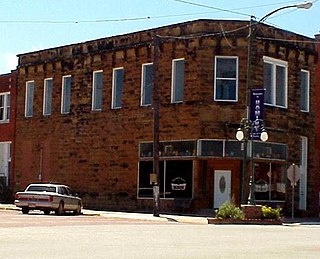
The Bank of Hominy, at W. Main St. and S. Price Ave. in Hominy, Oklahoma, is a building constructed in 1906, two years after the Oklahoma oil boom of 1904. It is one of four small bank buildings built in Richardsonian Romanesque style in Osage County, Oklahoma during 1904–1911. The others are Bank of Burbank, Bank of Bigheart, and Osage Bank of Fairfax.
The Bank of Burbank was a bank in Burbank, Oklahoma, and its historic bank building survives. The building was built in 1910. The bank operated through the Great Depression, and continued in business until 1948, when the bank ceased operating. The building was used for 30 years as the Burbank post office, and subsequently was renovated for use as a private residence. It was listed on the National Register of Historic Places in 1984.

The Detroit Naval Armory is located at 7600 East Jefferson Avenue in Detroit, Michigan. It is also known as the R. Thornton Brodhead Armory. The armory was designated a Michigan State Historic Site in 1980 and listed on the National Register of Historic Places in 1994.

The Flushing Armory is a historic National Guard armory building located in Flushing, Queens. New York City. It is a brick and stone castle-like structure built in 1905–1906, designed to be reminiscent of medieval military structures in Europe. It was designed by state architect George L. Heins.

The 369th Regiment Armory is a historic National Guard Armory building located at 2366 Fifth Avenue, between West 142nd and 143rd Streets, in Harlem, Manhattan, New York City. It was built for the 369th Regiment, also known as the "Harlem Hellfighters", founded in 1913 as the first National Guard unit in New York State composed solely of African-Americans. It later became home to the 369th Sustainment Brigade.
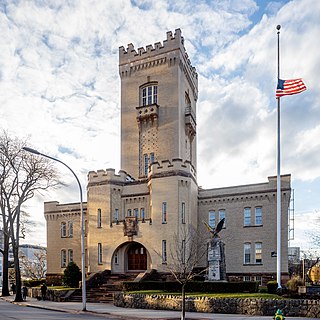
The White Plains Armory is a historic building in White Plains, New York, in Westchester County.

The 14th Regiment Armory, also known as the Eighth Avenue Armory and the Park Slope Armory, is a historic National Guard armory building located on Eighth Avenue between 14th and 15th Streets in the South Slope neighborhood of Brooklyn, New York City, United States. The building is a brick and stone castle-like structure, and designed to be reminiscent of medieval military structures in Europe. It was built in 1891–95 and was designed in the Late Victorian style by William A. Mundell.
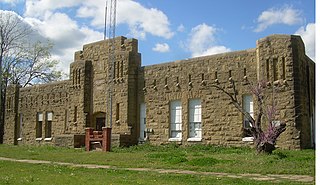
Bryan W. Nolen was an Oklahoma City, Oklahoma architect who served as a Major in the Oklahoma National Guard. He designed numerous armories built under the Works Progress Administration. He is credited with more than 20 buildings that are preserved and listed on the National Register of Historic Places.

The Duluth Armory is a former armory and event venue in the East Hillside neighborhood of Duluth, Minnesota, United States. It was built in 1915 for the National Guard and naval militia, and expanded in 1941. From the beginning the National Guard also rented out the drill hall as an event venue, as it provided a larger and more flexible space than any other local venue until the construction of the Duluth Arena-Auditorium in 1966.

The Ashland Oregon National Guard Armory is an armory building located in Ashland, Oregon, in the United States. It was designed by William C. Knighton, Oregon's first State Architect, and was built from 1912 to 1913. The armory displays California Mission and Gothic Revival architectural styles and remains one of four pre-World War I armories in western Oregon. It is listed on the National Register of Historic Places.

The Osage Round House is a 16-sided structure used for Osage Ceremonial dances such as the Inlonska. It is the only such round house standing in Osage County, Oklahoma.

The Hominy School, constructed in 1904, is 50 feet x 40 feet, and 20 feet high. The bell tower was removed in the 1940s, but replaced in 1980 with the original bell. It was the first and oldest school in Hominy.
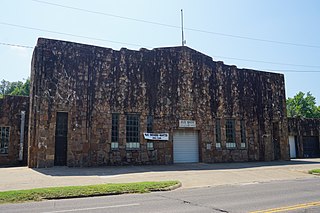
The Idabel Armory in Idabel, Oklahoma was built in 1936 as a Works Progress Administration (WPA) project. It was listed on the National Register of Historic Places in 1988.
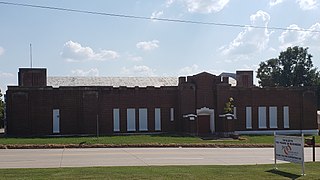
The Holdenville Armory, at US 270 and N. Butts St. in Holdenville, Oklahoma, was built in 1936. It was listed on the National Register of Historic Places in 1936.

The Marland Filling Station at 102 South Wood in Hominy, Oklahoma was built in 1922. It was listed on the National Register of Historic Places in 2002.
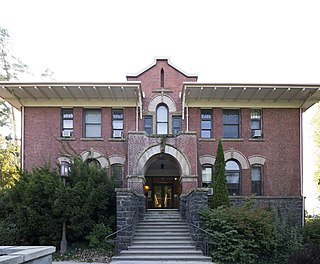
The University of Idaho Gymnasium and Armory is a historic building in the northwest United States, on the campus of the University of Idaho in Moscow, Idaho. On the southwest corner of Campus Drive and University Avenue, just northwest of the Administration Building, it was built as a gym and armory in 1903.

The Fred and Adeline Drummond House is a home built in Hominy, Oklahoma in 1905 for Frederick Drummond and his wife Adeline Gentner. The home was given to the Oklahoma Historical Society in 1980 and added to the National Register of Historic Places in 1981. The listing included three contributing buildings, including the main house and a tiny home termed the "Moses House". The property is operated as a historic house museum by the Oklahoma Historical Society.





















